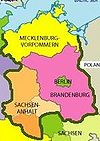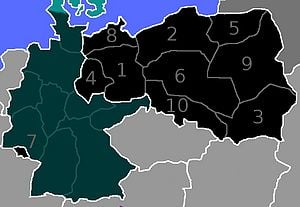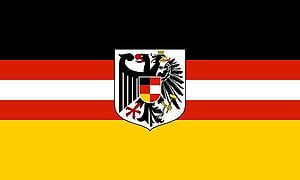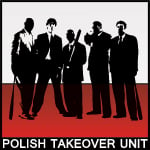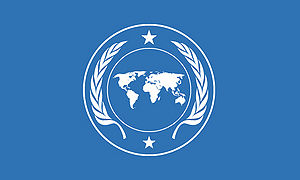History of Germany
| Languages: | ||||||||||||||||||||||||||||||||||||||||||||||||||||||||||||||||||||||||||||||||||||||
| ||||||||||||||||||||||||||||||||||||||||||||||||||||||||||||||||||||||||||||||||||||||
History
Early History
Sweden attacks Germany
Germany was an independent nation until Sweden attacked it on 1 May 2008. This event is called the Sweden-Germany War. Germany lost most of its territory and was heavily controlled by Sweden.
Annexion of Poland
At the end of May, in an attempt to gain more territory, Germany attacked Poland. Germany won the Germany-Poland War and annexed the entire country.
After the election of Popolo as the German President (whose ascent to power was tainted by accusations of fraud), the German Government cancelled many trade and Mutual Protection agreements with other nations. The cancellation of a four-month mutual protection pact with Sweden had thrown into doubt the continued legality of the German State, as the protection pact stated that if the pact's conditions are not maintained or met by Germany, then Germany, along with its treasury, belongs to Sweden. The situation escalated into the Second Sweden-Germany War.
Rebirth of Germany
On November 19, 2008, rebel groups in Germany, along with another force from the Czech Republic, began the first multi-region resistance war in Erepublik, known as the German Independence War. Germany would regain control of five of its original territories. Swedish soldiers had strict orders not to fight against the German resistance, as the war was approved of by the Swedish congress. On the 2nd of December the Swedish Congress halted the German resistance war after the president of Germany threatened Sweden with a trade embargo[1] if they didn't return the German Marks (DEM) that they had in their possession.
In a close presidential race, Freie Deutsche Demokraten candidate DKN beat Federal Social Democrat Party candidate Justin Tyme by a margin of 6 votes in the December 2008 election.
Restored Germany
Operation Burning Spirit
On January 10, 2009, resistance wars were started in all 6 remaining German territories controlled by Sweden in Operation Burning Spirit. With the help of PEACE Global Community, Germans were able to regain their original territories and restore the country to its former size. The wars were started in response to stalls from the Swedish government in giving Germany its territories back. Swedish officials were upset by Germany's actions and Misho, Sweden's Minister of Defense, wrote several articles comparing Germany to Nazis and spreading propaganda that Germany held plans for imperialism.
Isy vs. Nolan
There were two candidates for the February presidential election: Isy (FDD) and Nolan Pitler, who lost the party president seat to Isy, but was allowed to run for President by Lhasa, president of Open Mind Germany. Despite many political leaders discouraging Pitler from running, he and his supporters pressed onward to the election, with the objective to "ensure democracy in Germany." Isy would win with 94 votes to Pitler's 41.
Germany-Austria
Austro-German Union
On 27 February, 2009, Isy, President of Germany, and Chicco, president of Austria, both signed an agreement to go to induct Austria into Germany, forming a peaceful union in eRepublik, which would be called Germany-Austria. Austria would join through peaceful and regulated war, and the conduct of the union was determined by a pre-written contract signed by both presidents.
Splitting of the Union
Shortly after uniting with Austria, Austro-German people began talks of joining an alliance. After a couple weeks of deliberation, Germany-Austria joined ATLANTIS, and PEACE Global Community countries Italy and Hungary began the resistance effort known as the Austria-PEACE Resistance War throughout the Austrian regions in an effort to "liberate the oppressed Austrian people." The war would result in a PEACE-despising Germany, and a free Austria, where Italy, Hungary and Slovenia kept most regions until Austrian resistance leader Metallon could organize government and population in Austria.
Post-Austrian Germany
Continued Swedish Aggression
In the May 2009 presidential elections, Swedish candidate Kalle Holm promised the Swedish people a war with Germany if he was re-elected. Holm won the election and posted a second article announcing his intentions to persuade the rest of the ATLANTIS members to vote Germany out of the alliance. Germany, a passive member of ATLANTIS hoping to become an active one, pleaded the rest of ATLANTIS to vote against kicking Germany out.
Kalle Holm stated that after voting Germany out of the alliance, Sweden would declare war on Germany and attack it to "show the world Sweden's might." This was only a little over a month that Sweden agreed to let Germany into the alliance as temporary trial member originally.
Declaration of War
On May 18 2009, after weeks of diplomatic attempts to gather support for either side of the Sweden-Germany conflict, Sweden declared war on Germany and began the Third Sweden-Germany War. Much of ATLANTIS sided with Germany, however after some time the United States of America and the United Kingdom both officially declared neutrality, though many citizens still supported the German war effort.
Polish Political Takeover
Partly through the war, citizens of Poland moved to Germany and ran for congress. Many candidates made it in, and after some research, it was discovered that many of them were multis. They were then reported and mostly banned, allowing Germans to once again control their congress.
shoot's Betrayal
shoot, a half-year veteran "German" politician, ran for president as the only candidate besides Gobba. shoot received additional support from Swedish and Polish citizens who moved to Germany to vote him into office. After illegitimately winning the presidential election, shoot began to hand over German regions to the Swedish, and published an article disclosing his infiltration of the German state.
With only the region of Vorarlberg left to Germany, the Swedes started a resistance war that would return the region to Austria and destroy the remainder of the German state, and succeeded.
PEACE Liberation of Germany
Just a few days following the complete conquer of German lands in the Third Sweden-Germany War, PEACE forces from Italy, Hungary, and France would push Swedish and Polish troops out of occupied Germany, escalating the conflict into the Central European War.
After the liberation of Germany, Hungary, Italy, and France made negotiations on the returning of German regions to Germany. Hungary and France would give back the regions uncontested, with the exceptions of Mecklenburg-Western Pomerania and Hesse for discussed purposes. Negotiations with Italy led to a contract, in which Germany would pay Italy for war costs in return for the Italian-occupied regions.
Germany during the Second Polish Political Takeover
Polish Political Takeover
In July the Polish Takeover Unit (PTU) - a team lead and organised by aVie - attempted and succeeded in PTOing Germany in the July 2009 Congressional Elections. After that, a new party-the intentionally misleadingly named PEACE Party-was founded and also attempted to win the presidential elections. This failed and Gobba secured his office. But a few days before the August 2009 congressional elections the PTU successfully impeached Gobba (22:11) and the Polish candidate Adam Blayer was president of Germany for 7 days, before successfully being impeached by the August 2009 congress, which was without any PTU members.
654,800 DEM Coup
During the time of the takeover the Polish raised over ![]() 3000 GOLD and in act of economic sabotage used it to print 654,800 DEM. This move largely halted the German economy by causing massive inflation. Instantly the German congress started blocking this money and with the help of Hungary, and succeeded in securing half a million DEM. In the end the Poles successfully gained 100,000 DEM and Germany received 500,000 DEM. In a follow-up operation, Hungary attacked and occupied Germany, with the exception of the Saarland. These operations costed about
3000 GOLD and in act of economic sabotage used it to print 654,800 DEM. This move largely halted the German economy by causing massive inflation. Instantly the German congress started blocking this money and with the help of Hungary, and succeeded in securing half a million DEM. In the end the Poles successfully gained 100,000 DEM and Germany received 500,000 DEM. In a follow-up operation, Hungary attacked and occupied Germany, with the exception of the Saarland. These operations costed about ![]() 400 GOLD with an additional
400 GOLD with an additional ![]() 400 GOLD for the revolutions which followed afterwards to return Germany's regions. All costs were covered by medal auctions, which in the end even brought a large surplus of gold!
400 GOLD for the revolutions which followed afterwards to return Germany's regions. All costs were covered by medal auctions, which in the end even brought a large surplus of gold!
Germany as a part of PEACE
Under the presientship of The German Eagle in September and October 2009, Germany was permitted to join PEACE GC and has been a full-harted Member of the Alliance and a large contributer to the PEACEkeepers. On 21st November Donnie Bronco announced the withdrawal from PEACE GC, after the alliance fell apart.
Germany as a founder member of Phoenix
After the split of PEACE GC, Germany was a founder member of the successor-alliance Phoenix. Moreover the current German president Donnie Bronco is one of the Secretary-Generals.
Poland conquers Germany
At December 15 2009, Poland successfully conquered the German regions Brandenburg and Berlin, Mecklenburg-Western Pomerania and Saxony. One Day later Germany re-attacked Saxony but lost closely. Instead Germany was able to gain control of the region Syddanmark, which was occupied by Sweden at this time, after the Swedish president retreated from the battlefield. On December 31 2009 the attack of some other regions began. Poland quickly gained some other regions in Germany, but activated mighty MPPs. With conquering Hesse, they destroyed one of the three German Q5-hospitals.
While presidential elections on 5th January 2010 - when Konrad Neumann became the new president - Germany was reduced to three regions (Saarland, Bavaria and Rhineland-Palatinate). Finally on January 8th, Germany was defeated by Poland at the Battle of Saarland.
Liberation War
On January 21 Germany started multiple resistance wars and - with the help of Phoenix - Germany was able to regain control about Bavaria and Saarland.
On 1st of March 2010 Germany got back a third region, Mecklenburg-Western Pomerania, back. It was given to from Poland to Sweden after the War. On 28th of February Sweden tried to conquer Denmark. Phoenix started resistance wars in the occupied German regions. Sweden focused on the more important region Schleswig-Holstein and Hamburg, which they defended successfully, but had to sacrifice Mecklenburg-Western Pomerania. Meanwhile Denmark remaining on the map and signed a MPP with Phoenix superpower Serbia to avoid further Swedish attacks.
In the mid of March 2010 another multi-resistance war was launched and Hesse was liberated from the polish occupants. On 30th of March the regions Lower Saxony and Bremen and Baden-Wurttemberg were liberated from Spain by resistance wars.
While the huge offensive in April 2010 on polish occupied Rhone Alps (original French region) two of the last three remaining regions, Brandenburg and Berlin (High Grain) ans Saxony were reconquered.
The last region - Schleswig-Holstein and Hamburg - was reconquered by a resistance war against swedish occupants on May 1 2010.
Agreement with Slovenia
At the start of June 2010, Letnix (German CP) and Blaz Gutman (Slovenian CP) made an agreement to give Slovenia, which has no natural high regions, the German core region Schleswig-Holstein and Hamburg (high grain). For a certain rental (![]() 100 GOLD Gold / month) Slovenia got the possibility to have its own high region. They swapped northwards with the help of Austria. After the conquest of Schleswig-Holstein and Hamburg they immediately moved the majority of their active population to SHH and built up Q5 Hospital and Defense System to make possible resistance wars expensive.
100 GOLD Gold / month) Slovenia got the possibility to have its own high region. They swapped northwards with the help of Austria. After the conquest of Schleswig-Holstein and Hamburg they immediately moved the majority of their active population to SHH and built up Q5 Hospital and Defense System to make possible resistance wars expensive.
Also Germany got Slovenia's region Upper Carniola as a strategic centre in the balcan area, but lost it a few weeks later.
